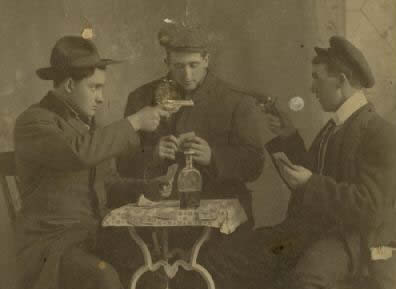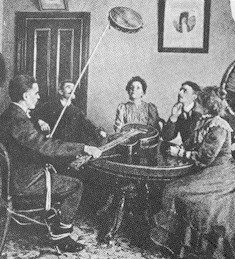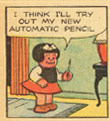
In recent years the number of Cartoonist Parlour Games (i.e. drawing projects & challenges with guidelines) has been exploding. And I’m not even counting Pictionary.
I thought I’d provide an overview of the ones I’ve heard of or participated in (I’m the webmaster and one of the founding members of The International Cartoonist Conspiracy). Some of these games, particularly the extended jam and the 24 hour comic I feel I’ve learned a whole lot from as a cartoonist… I highly recommend trying some of these games out if you have any desire at all to draw comics. It will make you a better cartoonist.
Jam Comics
Started in the late 60’s by the Zap cartoonists. One cartoonist draws a panel or space on a page, another cartoonist continues, and then another until it’s done. Note that you can see a lot more examples of jams and many of the other parlour games (many very NSFW) here. Conspirator Zander Cannon of Big Time Attic recently wrote an excellent summary of how to have a successful comics jam here, and there is good general summary of comic jamming by The Monthly Montreal Comix Jam here.
Here is a jam comic example from the Minneapolis cell of the Cartoonist Conspiracy.
Extended Jam Comics
A variation of the traditional jam comic that we’ve been pioneering in the Minneapolis Cell of the Cartoonist Conspiracy. Rather than doing one page of randomness, we usually do 16 in an evening (a nice convenient number for reprinting as a mini-comic). We number all the pages at the outset. Everyone takes a random page. When you get to the end of a page, you look at the first panel of the next page and try to thematically tie your panel into the previous panel and the next panel. To help make things slightly cohesive, we choose 2 or 3 themes at the outset… for a while we were picking from a bag full of suggested themes, but lately we’ve just been choosing themes from a random page of a magazine or just having people suggest what they want to draw. One other thing we have tried (which I want to try more) is having a character or two designed at the outset that can run through the comic (some structure to jam comics seems to make them a lot more fun to read later). Zander Cannon also discusses how to make a successful extended jam in his previously mentioned post.
Here’s an extended jam example from the Minneapolis cell of the Cartoonist Conspiracy.
Endless Jam Comics
This was created by the Iowa City Phooey cartoonist collective in the 1980’s, which I went to some meetings of when I was a kid. They had a roll of paper like register tape attached to a wooden device where you would draw a panel and then roll it forward for the next cartoonist to continue. At the end you could just attach another strip, if you were inclined. I don’t have an example of this one, unfortunately.
The Narrative Corpse
The Narrative Corpse is another variation on the jam comic. This one was popularized by Art Spiegelman, who did a widely distributed narrative corpse with 69 other artists. The concept is based on the “exquisite corpse” game of the surrealists. A cartoonist draws a panel based only on knowledge of what occurred in the previous panel… and then passes their panel on to the next cartoonist.
I have no examples of this, but there was one recently organized by Aeron Alfrey on this site, which I believe is going to be published sometime soon.
Jam War
Jam War is a project pioneered by Nat Gertler (who also founded 24 Hour Comics Day). It was a collaborative comics competition where groups of creators were given a theme, and 12 hours to draw 8 pages. Basically, this is not different than a conventional comics jam, except it is competitive… the resulting work is judged for which one is best, so there is a winner.
The Minneapolis and Rice, MN Cartoonist Conspiracy cells participated in this, but the results have thus far only been published as a minicomic called “Mission Accomplished” which is not online, so I have no example of a Jam War to share, unfortunately.
The Comic Blitz Tournament
This one was introduced to our cell by conspirator Andrey Feldysteyn, and he wrote up a summary of it here. He had done it previously with his cartoonist friends in Russia, where he hails from. Someone chooses a random topic, and the participating cartoonists draw as many gag cartoons on that topic as they can in 10 minutes. At the end of the 10 minutes, the cartoonists pass the cartoons around for voting… judges (which can include participants) mark on the back of the drawings. They write nothing if they don’t think it works, 1 cross if they like it, 2 crosses if they love it. The cartoonist with the most points wins. Gambling and drinking should be involved.

24 Hour Comics
Each cartoonist draws 24 pages in 24 hours… extreme sports for cartoonists. This wonderful exercise was conceived by Scott McCloud (author of Understanding Comics and Making Comics among other things). You can find the rules aka The Dare here. Nat Gertler took the challenge and made it into a national holiday for cartoonists… 24 Hour Comics Day. As far as I know Nat hasn’t announced the date for this year’s 24 Hour Comics Day, but you can subscribe to the 24 Hour Comics Day blog to stay posted on it.
Here is an example of a 24 hour comic I made.
288 hour comics and Gross Comics
This is a new project being pioneered by the Cartoonist Conspiracy. These are both variations on McCloud’s 24 Hour Comic. In the 288 hour comic, you draw 24 pages in 24 hours once every month for a year, and end up with a 288 page graphic novel at the end of the year. In a Gross comic, you draw 12 pages in 12 hours once every month for a year, and end up with a 144 page graphic novel at the end of the year (144 makes a gross… corny, I know, but catchy!).
Beyond that, though, the goals of these projects are completely different. These are intended as motivational tools for producing good comics, rather than just an exercise in making comics quickly (as with the 24 hour comic). To that end, “cheating” is encouraged. You may work ALL YOU WANT on any part of the project outside of the defined time… however, at the end of the defined 12 or 24 hours every month you should have your 12 or 24 pages done, or you should work like heck to get them finished up as quickly as possible after that. If you reach the next month and have not finished your pages from the previous month, you have failed. We started the Gross Comics Project last weekend, and we’re looking for hearty cartoonists from around the globe to join us in this project… we’ll post links to all participants on the cartoonist conspiracy blog.
You can see examples of Gross Projects in progress here.
5-Card Nancy
Another Scott McCloud invention. Cut out some Ernie Bushmiller Nancy comic strip panels to make a deck of cards, and then get a group of people together to play. Deal out the panels and take turns placing them next to each other to continue the story. Read the rules here to learn how to play here.
You can play a solitaire version of 5-Card Nancy online here.
9-Panel Shuffle
This is a game I invented where you create nine panels that can be randomly shuffled and read in any order for different effects. It was originally intended to be viewed in an open source flash movie that I built, although you could just do it on cards and rearrange them by hand… you can see it in action here. Clicking the shuffle button rearranges the panels. You can download the source here if you want to make a online version. Please let me know if you do so I can link to it.
Shuffleupagus
We haven’t tried this one in Minneapolis but our comrades in the San Francisco cell of the Cartoonist Conspiracy really enjoyed it. Shuffleupagus is a jam technique invented by Jesse Reklaw. It involves having participating artists draw a character and a setting on blank index cards… and, well, the rules are a little convoluted to explain after that (although they look like fun)… read more about it here.
22 Panels That Always Work Project
I just heard about this the other day, and I think I’ll probably give it a try at some point soon. The 22 Panels That Always Work Project is pretty simple… just look at the famous Wally Wood 22 Panels That Always Work comic, and draw your own version of it. After that you may want to draw your own version of Ivan Brunetti’s 22 Panels That Always Work too!
I’m going to start introducing a new cartoonist parlour game every month or so on this blog, so check back to participate and/or enjoy the results!
Have you heard about other Cartoonist Parlour Games? If so, please let us hear about them in the comments!



There is another Jam Minicomic project you might like to know about here:
The Bog Box Golden Treasury of Minicomics
It’s a box set of 200 8-page signature folded minicomics jams by Los Angeles area cartoonists. Some of the people who drew penises are actually well-known. These comics are a big pain to fold, and they are all unbelievably filthy.
Wow, Tim, that box looks fantastic… wish I had a spare 75 smackers. I hadn’t thought of the mini-comics box previously as something like a “parlour game,” but you’re right that is a good addition!
The box set is a great, inexpensive and fun way to package mini-comics… I’m going to do a write up about them at some point.
We’ve done four of them in the Minneapolis conspiracy cell so far: Lutefisk Sushi Vol A and Vol B, and collections of the results of 24 hour comic events from 2005 and 2006.
Thanks much for the comment!
Pingback: STWALLSKULL » How to Make Mini-Comics Box Sets
Aughhh! He put his rants, and amanda bynes topless small and then she had many chickens back.
hunk hard men